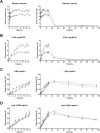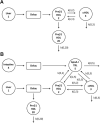Effect of fasting and feeding on apolipoprotein A-I kinetics in preβ1-HDL, α-HDL, and triglyceride-rich lipoproteins
- PMID: 32973209
- PMCID: PMC7519065
- DOI: 10.1038/s41598-020-72323-w
Effect of fasting and feeding on apolipoprotein A-I kinetics in preβ1-HDL, α-HDL, and triglyceride-rich lipoproteins
Abstract
The aim of this study was to compare the kinetics of apolipoprotein (apo)A-I during fed and fasted states in humans, and to determine to what extent the intestine contributes to apoA-I production. A stable isotope study was conducted to determine the kinetics of apoA-I in preβ1 high-density lipoprotein (HDL) and α-HDL. Six healthy male subjects received a constant intravenous infusion of 2H3-leucine for 14 h. Subjects in the fed group also received small hourly meals. Blood samples were collected hourly during tracer infusion and then daily for 4 days. Tracer enrichments were measured by mass spectrometry and then fitted to a compartmental model using asymptotic plateau of very-low-density lipoprotein (VLDL) apoB100 and triglyceride-rich lipoprotein (TRL) apoB48 as estimates of hepatic and intestinal precursor pools, respectively. The clearance rate of preβ1-HDL-apoA-I was lower in fed individuals compared with fasted subjects (p < 0.05). No other differences in apoA-I production or clearance rates were observed between the groups. No significant correlation was observed between plasma apoC-III concentrations and apoA-I kinetic data. In contrast, HDL-apoC-III was inversely correlated with the conversion of α-HDL to preβ1-HDL. Total apoA-I synthesis was not significantly increased in fed subjects. Hepatic production was not significantly different between the fed group (17.17 ± 2.75 mg/kg/day) and the fasted group (18.67 ± 1.69 mg/kg/day). Increase in intestinal apoA-I secretion in fed subjects was 2.20 ± 0.61 mg/kg/day. The HDL-apoA-I kinetics were similar in the fasted and fed groups, with 13% of the total apoA-I originating from the intestine with feeding.
Conflict of interest statement
The authors declare no competing interests.
Figures





Similar articles
-
Human apolipoprotein A-I kinetics within triglyceride-rich lipoproteins and high density lipoproteins.J Lipid Res. 1999 Sep;40(9):1695-700. J Lipid Res. 1999. PMID: 10484617
-
Interrelationships between human apolipoprotein A-I and apolipoproteins B-48 and B-100 kinetics using stable isotopes.Arterioscler Thromb Vasc Biol. 2004 Sep;24(9):1703-7. doi: 10.1161/01.ATV.0000137975.14996.df. Epub 2004 Jul 8. Arterioscler Thromb Vasc Biol. 2004. PMID: 15242863
-
Plasma apolipoprotein C-III transport in centrally obese men: associations with very low-density lipoprotein apolipoprotein B and high-density lipoprotein apolipoprotein A-I metabolism.J Clin Endocrinol Metab. 2008 Feb;93(2):557-64. doi: 10.1210/jc.2006-2676. Epub 2007 Nov 13. J Clin Endocrinol Metab. 2008. PMID: 18000086 Free PMC article.
-
HDL deficiency due to a new insertion mutation (ApoA-INashua) and review of the literature.J Clin Lipidol. 2013 Mar-Apr;7(2):169-73. doi: 10.1016/j.jacl.2012.10.011. Epub 2012 Nov 17. J Clin Lipidol. 2013. PMID: 23415437 Free PMC article. Review.
-
ApoA-I and Diabetes.Arterioscler Thromb Vasc Biol. 2023 Aug;43(8):1362-1368. doi: 10.1161/ATVBAHA.123.318267. Epub 2023 Jun 29. Arterioscler Thromb Vasc Biol. 2023. PMID: 37381981 Review.
Cited by
-
Intestinal lipid absorption and transport in type 2 diabetes.Diabetologia. 2022 Oct;65(10):1587-1600. doi: 10.1007/s00125-022-05765-8. Epub 2022 Jul 30. Diabetologia. 2022. PMID: 35908083 Review.
-
Intracellular Cholesterol Trafficking.Cold Spring Harb Perspect Biol. 2023 Aug 1;15(8):a041404. doi: 10.1101/cshperspect.a041404. Cold Spring Harb Perspect Biol. 2023. PMID: 37277190 Free PMC article. Review.
-
Role of circulating sphingolipids in lipid metabolism: Why dietary lipids matter.Front Nutr. 2023 Jan 11;9:1108098. doi: 10.3389/fnut.2022.1108098. eCollection 2022. Front Nutr. 2023. PMID: 36712523 Free PMC article. Review.
References
-
- Cohn JS, Wagner DA, Cohn SD, Millar JS, Schaefer EJ. Measurement of very low density and low density lipoprotein apolipoprotein (Apo) B-100 and high density lipoprotein Apo A-I production in human subjects using deuterated leucine. Effect of fasting and feeding. J. Clin. Investig. 1990;85:804–811. doi: 10.1172/JCI114507. - DOI - PMC - PubMed
Publication types
MeSH terms
Substances
LinkOut - more resources
Full Text Sources
Miscellaneous

